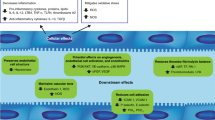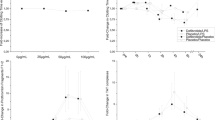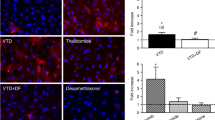Abstract
Defibrotide (DF), a polydeoxyribonucleotide with antithrombotic properties, has recently proven effective in patients with severe hepatic veno-occlusive disease (VOD), a life-threatening complication of high-dose chemo/radiotherapy regimens for stem cell transplantation. To understand the mechanism of its beneficial effect, we studied the impact of DF on the expression of tissue factor (TF) and fibrinolytic proteins (PAI-1 and t-PA) on endothelial cells. The in vitro response to DF of two types of human endothelial cells (ECs) of different origins, that is from macrovascular (HUVEC) and microvascular (HMEC-1 cell line) beds, was evaluated in the presence or absence of a proinflammatory stimulus (ie bacterial endotoxin, LPS). The results show that DF was able to significantly reduce the LPS-induced TF expression by HMEC-1, and less prominently by HUVEC. In addition, DF importantly influenced the fibrinolytic properties of both HMEC-1 and HUVEC. Specifically, it dose-dependently counteracted the LPS-induced increase in PAI-1 levels and decrease in t-PA activity expression. It also significantly incremented t-PA antigen in resting EC. Decreasing the procoagulant activity and increasing the fibrinolytic potential of EC favors an anticoagulant phenotype of the endothelium, which may protect from fibrin deposition and vascular occlusion.
This is a preview of subscription content, access via your institution
Access options
Subscribe to this journal
Receive 12 print issues and online access
$259.00 per year
only $21.58 per issue
Buy this article
- Purchase on Springer Link
- Instant access to full article PDF
Prices may be subject to local taxes which are calculated during checkout




Similar content being viewed by others
References
Bianchi G, Barone D, Panzarotti E, Tettamanti R, Porta R, Moltrasio D et al. Defibrotide, a single-stranded polydeoxyribonucleotide acting as an adenosine receptor agonist. Eur J Pharmacol 1993; 238: 327–334.
Cimminiello C . Clinical trials with defibrotide in vascular disorders. Semin Thromb Hemost 1996; 22 (Suppl. 1): 29–34.
Violi F, Marubini E, Coccheri S, Nenci GG . Improvement of walking distance by defibrotide in patients with intermittent claudication. Results of randomized, placebo-controlled study. Thromb Haemost 2000; 83: 672–677.
Palmer KJ, Goa KL . Defibrotide. A review of its pharmacodynamic and pharmacokinetic properties, and therapeutic use in vascular disorders. Drugs 1993; 45: 259–294.
Bearman SI . The syndrome of hepatic veno-occlusive disease after bone marrow transplantation. Blood 1995; 85: 3005–3020.
Richardson PG, Guinan EC . Hepatic veno-occlusive disease following hematopoietic stem cell transplantation. Acta Haematol 2001; 106: 57–68.
Richardson PG, Elias AD, Krishnan A, Wheeler C, Nath R, Hoppensteadt D et al. Treatment of severe veno-occlusive disease with defibrotide: compassionate use results in response without significant toxicity in a high-risk population. Blood 1998; 92: 737–744.
Chopra R, Eaton JD, Grassi A, Potter M, Shaw B, Salat C et al. Defibrotide for the treatment of hepatic veno occlusive disease: results of the European compassionate-use study. Br J Haematol 2000; 111: 1122–1129.
Richardson PG, Murakami C, Jin Z, Warren D, Momtaz P, Hoppensteadt D et al. Multi-institutional use of defibrotide in 88 patients post stem cell transplant with severe veno-occlusive disease and multi-system organ failure. Response without significant toxicity in a high risk population and factors predictive of outcome. Blood 2002; 100: 4337–4343.
Rickles FR, Falanga A . Molecular basis of the relationship between thrombosis and cancer. Thromb Res 2001; 102: V215–V224.
Falanga A . Tumor cell prothrombotic properties. Haemostasis 2001; 31 (Suppl. 1): 1–4.
Lee AY, Levine MN . The thrombophilic state induced by therapeutic agents in the cancer patient. Semin Thromb Haemost 1999; 25: 137–145.
Cozzolino F, Torcia M, Miliani A, Carossino AM, Giordani R, Cinotti S et al. Potential role of interleukin-1 as the trigger for diffuse intravascular coagulation in acute nonlymphoblastic leukemia. Am J Med 1988; 84: 240–250.
Falanga A, Marchetti M, Giovanelli S, Barbui T . All-trans retinoic acid counteracts endothelial cell procoagulant activity induced by a human promyelocitic leukemia-derived cell line (NB4). Blood 1996; 87: 613–617.
Barbui T, Finazzi G, Falanga A . The impact of all-trans-retinoic acid on the coagulopathy of acute promyelocytic leukemia. Blood 1988; 91: 3093–3102.
Garlanda C, Dejana E . Heterogeneity of endothelial cells. Specific markers. Arterioscler Thromb Vasc Biol 1997; 17: 1193–1202.
Kwaan HC, Gordon LI . Thrombotic microangiopathy in the cancer patient. Acta Haematol 2001; 106: 57–68.
Hizal N, Bilsel S, Emerk K . Investigation of the fibrinolytic activity of defibrotide fractions. Gen Pharmacol 1994; 25: 1617–1620.
Zhou Q, Chu X, Ruan C . Defibrotide stimulates the expression of thrombomodulin in human endothelial cells. Thromb Haemost 1994; 71: 507–510.
Ades EW, Candal FJ, Swerlick RA, George VG, Summers S, Bosse DC et al. HMEC-1: establishment of an immortalized human microvascular endothelial cell line. J Invest Dermatol 1992; 99: 683–690.
Bouis D, Hospers GA, Meijer C, Molema G, Mulder NH . Endothelium in vitro: a review of human vascular endothelial cell lines for blood vessel-related reasearch. Angiogenesis 2001; 4: 91–102.
Jaffe EA, Nachman RL, Becker CG, Minick CR . Culture of human endothelial cells derived from umbilical cord veins. Identification of morphology and immunologic criteria. J Clin Invest 1973; 52: 2745–2756.
Chandler WL, Trimble SL, Loo SC, Mornin D . Effect of PAI-1 levels on the molar concentrations of active tissue plasminogen activator (t-PA) and t-PA/PAI-1 complex in plasma. Blood 1990; 76: 930–937.
Bairey O, Kirgner I, Yakobi M, Hamdan A, Ben-Ari Z, Shaklai M . Clinical severe hepatic veno-occlusive disease during induction treatment of acute monoblastic leukemia managed with defibrotide. Am J Hematol 2002; 69: 281–284.
Mor E, Pappo O, Bar-Nathan N, Shaharabani E, Shapira Z, Tur-Kaspa R et al. Defibrotide for the treatment of veno-occlusive disease after liver transplantation. Transplantation 2001; 72: 1237–1240.
Ferrari P, Clerici G, Gussoni G, Nazzari M . Defibrotide versus placebo in the treatment of intermittent claudication. A meta-analysis. Drug Invest 1994; 7:157–160.
Violi F, Ferro D, Saliola M, Quintarelli C, Basili S, Balsano F . Effect of oral defibrotide on tissue-plasminogen activator and tissue-plasminogen activator inhibitor balance. Eur J Clin Pharmacol 1992; 42:379–383.
Davi G, Catalano I, Belvedere M, Amato S, Mogavero A, Giammarresi C et al. Effects of defibrotide on fibrinolytic activity in diabetic patients with stable angina pectoris. Thromb Res 1992; 65:211–220.
Pasini FL, Frigerio C, Capecchi PL, Ceccatelli L, Messa GL, Franchi M et al. Modulation of venous endothelial activity and transcellular calcium transport by defibrotide: the adenosine hypothesis. Semin Thromb Haemost 1996; 22 (Suppl. 1): 15–20.
Hoppensteadt DA, Jeske W, Fareed J, Nicolaides AN . Physical and pharmacologic modulation of the vascular system as measured by the release of TFPI, and other mediators of antithrombotic actions. Int Angiol 1996; 15: 39–46.
Cella G, Sbarai A, Mazzaro G, Motta G, Carraro P, Andreozzi GM et al. Tissue factor pathway inhibitor release induced by defibrotide and heparins. Clin Appl Thromb Hemost 2001;7:225–228.
Berti F, Rossoni G, Omini C, Folco G, Daffonchio L, Vigano T et al. Defibrotide, an antithrombotic substance which prevents myocardial contracture in ischemic rabbit heart. Eur J Pharmacol 1987; 135: 375–382.
Ulutin ON, Balkuv-Ulutin S, Bezer-Goker B, Cizmeci G, Ferhanoglu B, Ozsoy Y et al. Effect of defibrotide on platelet function. Semin Thromb Hemost 1996; 22 (Suppl. 1): 21–24.
Di Perri T, Laghi Pasini F, Capecchi PL, Beccatelli L, Pasqui AL, Orrico A . Defibrotide in vitro inhibits neutrophil activation by Ca++ involving mechanism. Int J Tissue Reaction 1987; 9: 399–406.
Cirillo F, Margaglione M, Vecchione G, Ames PR, Coppola A, Grandone E et al. In vitro inhibition by defibrotide of monocyte superoxide anion generation: a possible mechanism for the antithrombotic effect of a polydeoxyribonucleotide-derived drug. Haemostasis 1991; 21: 98–105.
Evangelista V, Piccardoni P, de Gaetano G, Cerletti C . Defibrotide inhibits platelet activation by cathepsin G released from stimulated polymorphonuclear leukocytes. Thromb Haemost 1992;67:660–664.
Abbate R, Gori AM, Martini F, Attanasio M, Comeglio P, Giusti B et al. Defibrotide reduces monocyte PAI-2 and procoagulant activity. Semin Thromb Hemost 1995;21:245–250.
Beelen DW, Haralambie E, Brandt H, Linzenmeier G, Muller KD, Quabeck K et al. Evidence that sustained growth suppression of intestinal anaerobic bacteria reduces the risk of acute graft-versus-host disease after sibling marrow transplantation. Blood 1992; 80:2668–2676.
Blann A, Taberner DA . A reliable marker of endothelial cell dysfunction: does it exist? Br J Haematol 1995; 90: 244–248.
Colucci M, Balconi G, Lorenzet R, Pietra A, Locati D . Cultured endothelial cells generate tissue factor in response to endotoxin. J Clin Invest 1983; 71: 1893–1896.
Crossman DC, Carr DP, Tuddenhan EG, Pearson JD, McVey JH . The regulation of tissue factor mRNA in human endothelial cells in response to endotoxin or phorbol ester. J Biol Chem 1990; 265: 9782–9787.
Yang Y, Loscalzo J . Regulation of tissue factor expression in human microvascular endothelial cells by nitric oxide. Circulation 2000; 101: 2144–2148.
Salat C, Holler E, Kolb HJ, Reinhardt B, Pihusch R, Wilmanns W et al. Plasminogen activator inhibitor-1 confirms the diagnosis of hepatic veno-occlusive disease in patients with hyperbilirubinemia after bone marrow transplantation. Blood 1997; 89: 2184–2188.
Lee JH, Lee KH, Lee JM, Kim S, Seol M, Park CJ, Chi HS, Kang W, Kim ST, Kim WK, Lee JS . Plasminogen activator inhibitor-1 is an independent diagnostic marker as well as severity predictor of hepatic veno-occlusive disease after allogeneic bone marrow transplantation in adults conditioned with busulphan and cyclophosphamide. Br J Haematol 2002; 118: 1087–1094.
Eissner G, Multhoff G, Gerbitz A, Kirchner S, Bauer S, Haffner S et al. Fludarabine induces apoptosis, activation, and allogenicity in human endothelial and epithelial cells: protective effect of defibrotide. Blood 2002; 100: 334–340.
Acknowledgements
We acknowledge Dr M Iacobelli for providing Defibrotide (Gentium SpA, Villa Guardia, Como Italy) for helpful discussion and for providing DF. This work was partially supported by a grant to AF from the ‘Associazione Italiana per la Ricerca sul Cancro (A.I.R.C.)’.
Author information
Authors and Affiliations
Rights and permissions
About this article
Cite this article
Falanga, A., Vignoli, A., Marchetti, M. et al. Defibrotide reduces procoagulant activity and increases fibrinolytic properties of endothelial cells. Leukemia 17, 1636–1642 (2003). https://doi.org/10.1038/sj.leu.2403004
Received:
Accepted:
Published:
Issue Date:
DOI: https://doi.org/10.1038/sj.leu.2403004
Keywords
This article is cited by
-
A Systematic Review and Meta-Analysis of Studies of Defibrotide Prophylaxis for Veno-Occlusive Disease/Sinusoidal Obstruction Syndrome
Clinical Drug Investigation (2022)
-
Early modifications of the gut microbiome in children with hepatic sinusoidal obstruction syndrome after hematopoietic stem cell transplantation
Scientific Reports (2021)
-
The importance of endothelial protection: the emerging role of defibrotide in reversing endothelial injury and its sequelae
Bone Marrow Transplantation (2021)
-
Advances in the diagnosis and treatment of disseminated intravascular coagulation in haematological malignancies
International Journal of Hematology (2021)
-
Defibrotide enhances fibrinolysis in human endotoxemia – a randomized, double blind, crossover trial in healthy volunteers
Scientific Reports (2019)



